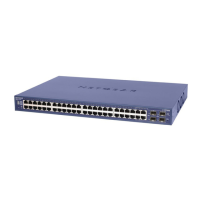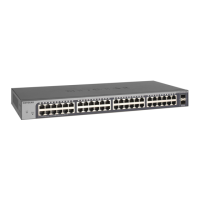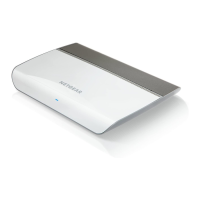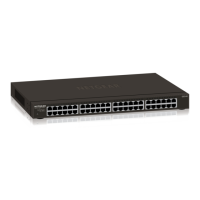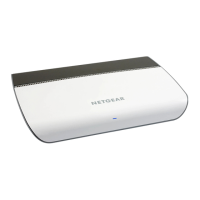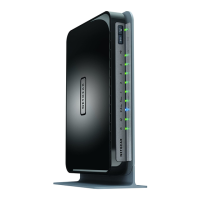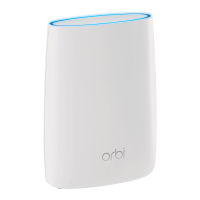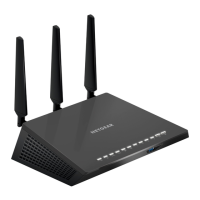Do you have a question about the NETGEAR GS748TNA and is the answer not in the manual?
Describes the target audience and their required skill level for the manual.
Explains how to navigate and utilize the manual's content and features effectively.
Details typographical and message formatting conventions used throughout the manual.
Explains how to navigate the manual if provided in HTML format.
Provides instructions on printing the manual from HTML or PDF versions.
Lists changes made to the document across different versions and dates.
Introduces switch management methods, including web-based and utility tools.
Lists hardware and software prerequisites for using the manual's applications.
Guides users on installing and using the utility in a DHCP-enabled network.
Describes setup procedures for the utility in networks without a DHCP server.
Details the steps to manually assign IP, subnet mask, and gateway for the switch.
Explains how to configure the host PC's network interface card settings.
Instructions on how to change the switch's password using the utility.
Outlines the process for upgrading the switch's firmware using the utility.
Describes how to close the Smartwizard Discovery Utility program.
Guides on how to access the switch's web interface via a browser.
Describes how to view system status, firmware version, IP address, and other details.
Guides on setting up the switch's IP address, subnet mask, and gateway.
Provides steps to change the default password for enhanced security.
Explains how to back up and restore the switch's configuration settings.
Details procedures for resetting the switch to factory defaults or rebooting it.
Details how to set up individual switch ports, including speed, duplex, and flow control.
Explains how to group multiple ports for increased bandwidth and redundancy.
Guides on configuring Simple Network Management Protocol for network monitoring.
Covers setting up Virtual Local Area Networks for network segmentation.
Explains how to designate a specific VLAN for switch management access.
Describes how to configure Spanning Tree Protocol for loop prevention in redundant networks.
Details configuration for IGMP snooping and static multicast group management.
Instructions on enabling support for larger Ethernet frame sizes.
How to configure bandwidth limits for ingress and egress traffic on ports.
Overview of Quality of Service settings for traffic prioritization.
Configuration for 802.1p priority levels and mapping to hardware queues.
Mapping DSCP values to 802.1p priorities for QoS implementation.
How to configure storm control to prevent network disruption from excessive traffic.
How to restrict switch management access based on IP addresses.
Manages access control using MAC addresses and VLAN IDs.
How to configure port mirroring to monitor network traffic.
Explains how to view detailed port traffic and error statistics.
Lists the technical specifications for the GS748T Smart Switch hardware.
Details performance metrics such as switching capacity and packet forwarding rate.
Outlines port characteristics, quality of service, and security features with default settings.
Explains the benefits of using VLANs for network management and segmentation.
Describes how packets are handled based on 802.1Q tagging and VLAN ID.
Provides a practical example demonstrating tagged and untagged VLAN traffic.
Explains VLANs confined to specific switch ports, without spanning across switches.
Demonstrates the configuration and behavior of port-based VLANs with example scenarios.
Provides guidelines for installing and ensuring performance of Fast Ethernet UTP cables.
Details the length limitations and specifications for Category 5 UTP cabling.
Lists electrical requirements and performance metrics for Category 5 UTP cable.
Explains the function of twisted pair cables and MDI/MDI-X ports.
Discusses requirements for patch panels and work area cables for network connectivity.
Guides on implementing Gigabit Ethernet using Category 5 cabling.
Specifies the maximum distance limitations for Ethernet cabling segments.
Explains return loss measurement in cabling and its impact on performance.
Defines and explains Near End Cross Talk (NEXT) in cabling performance.
Details the specifications and pin assignments for RJ-45 plugs and connectors.
Summarizes key requirements for optimal 1000BASE-T performance and cable installation.
Describes the target audience and their required skill level for the manual.
Explains how to navigate and utilize the manual's content and features effectively.
Details typographical and message formatting conventions used throughout the manual.
Explains how to navigate the manual if provided in HTML format.
Provides instructions on printing the manual from HTML or PDF versions.
Lists changes made to the document across different versions and dates.
Introduces switch management methods, including web-based and utility tools.
Lists hardware and software prerequisites for using the manual's applications.
Guides users on installing and using the utility in a DHCP-enabled network.
Describes setup procedures for the utility in networks without a DHCP server.
Details the steps to manually assign IP, subnet mask, and gateway for the switch.
Explains how to configure the host PC's network interface card settings.
Instructions on how to change the switch's password using the utility.
Outlines the process for upgrading the switch's firmware using the utility.
Describes how to close the Smartwizard Discovery Utility program.
Guides on how to access the switch's web interface via a browser.
Describes how to view system status, firmware version, IP address, and other details.
Guides on setting up the switch's IP address, subnet mask, and gateway.
Provides steps to change the default password for enhanced security.
Explains how to back up and restore the switch's configuration settings.
Details procedures for resetting the switch to factory defaults or rebooting it.
Details how to set up individual switch ports, including speed, duplex, and flow control.
Explains how to group multiple ports for increased bandwidth and redundancy.
Guides on configuring Simple Network Management Protocol for network monitoring.
Covers setting up Virtual Local Area Networks for network segmentation.
Explains how to designate a specific VLAN for switch management access.
Describes how to configure Spanning Tree Protocol for loop prevention in redundant networks.
Details configuration for IGMP snooping and static multicast group management.
Instructions on enabling support for larger Ethernet frame sizes.
How to configure bandwidth limits for ingress and egress traffic on ports.
Overview of Quality of Service settings for traffic prioritization.
Configuration for 802.1p priority levels and mapping to hardware queues.
Mapping DSCP values to 802.1p priorities for QoS implementation.
How to configure storm control to prevent network disruption from excessive traffic.
How to restrict switch management access based on IP addresses.
Manages access control using MAC addresses and VLAN IDs.
How to configure port mirroring to monitor network traffic.
Explains how to view detailed port traffic and error statistics.
Lists the technical specifications for the GS748T Smart Switch hardware.
Details performance metrics such as switching capacity and packet forwarding rate.
Outlines port characteristics, quality of service, and security features with default settings.
Explains the benefits of using VLANs for network management and segmentation.
Describes how packets are handled based on 802.1Q tagging and VLAN ID.
Provides a practical example demonstrating tagged and untagged VLAN traffic.
Explains VLANs confined to specific switch ports, without spanning across switches.
Demonstrates the configuration and behavior of port-based VLANs with example scenarios.
Provides guidelines for installing and ensuring performance of Fast Ethernet UTP cables.
Details the length limitations and specifications for Category 5 UTP cabling.
Lists electrical requirements and performance metrics for Category 5 UTP cable.
Explains the function of twisted pair cables and MDI/MDI-X ports.
Discusses requirements for patch panels and work area cables for network connectivity.
Guides on implementing Gigabit Ethernet using Category 5 cabling.
Specifies the maximum distance limitations for Ethernet cabling segments.
Explains return loss measurement in cabling and its impact on performance.
Defines and explains Near End Cross Talk (NEXT) in cabling performance.
Details the specifications and pin assignments for RJ-45 plugs and connectors.
Summarizes key requirements for optimal 1000BASE-T performance and cable installation.
| Model Number | GS748TNA |
|---|---|
| SFP Ports | 4 |
| Layer | Layer 2 |
| Switching Capacity | 96 Gbps |
| Forwarding Rate | 71.4 Mpps |
| MAC Address Table Size | 16K |
| Power over Ethernet (PoE) | No |
| Form Factor | Rack-mountable |
| VLAN Support | Yes |
| Quality of Service (QoS) | Yes |
| Product Type | Switch |
| Category | Network Switch |
| Jumbo Frame Support | 9KB |
| Management | Web-based, SNMP, CLI |
| Mounting | Rack |
| Operating Temperature | 0 to 50 °C |
| Storage Temperature | -20° to 70° C (-4° to 158° F) |
| Humidity | 90% maximum, non-condensing |
| Ports | 48 x 10/100/1000 Mbps Gigabit Ethernet |
